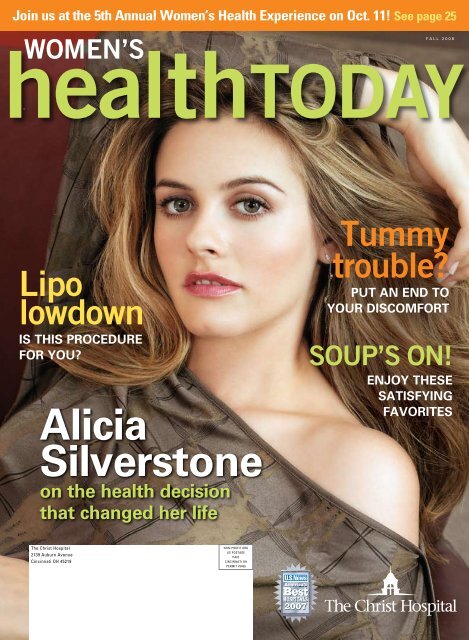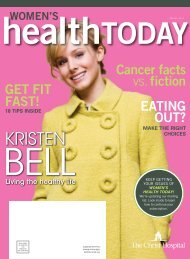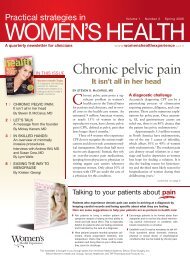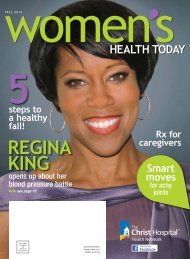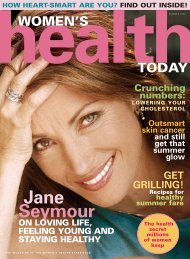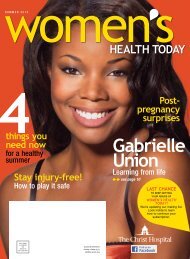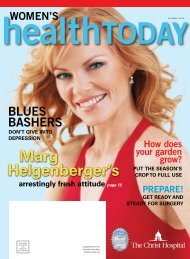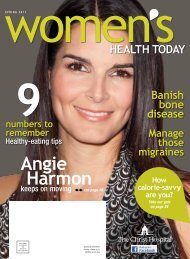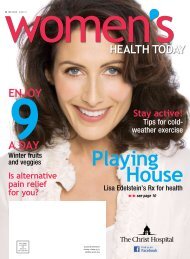Alicia Silverstone - The Christ Hospital
Alicia Silverstone - The Christ Hospital
Alicia Silverstone - The Christ Hospital
- No tags were found...
You also want an ePaper? Increase the reach of your titles
YUMPU automatically turns print PDFs into web optimized ePapers that Google loves.
in this issue . . .2 L E T T E R F R O M T H E F O U N D E RThinking about cosmetic surgery?3 Uncovering hidden heart threatsA simple screening can detect the problem4 Diabetes: <strong>The</strong> special risks for women5 Enjoy your retirement!How to make the most of your golden years56 H E A L T H H E A D L I N E SWhat’s making news in women’s health8 Looking at liposuctionWeigh the risks and benefits carefully9 S E X & G E N D E R M A T T E R SProtect yourself!Skin cancer is on the rise10 Vital and vibrant<strong>Alicia</strong> <strong>Silverstone</strong> opens up about the healthyhabits that changed her life1313 Be emergency-readyAssemble a kit to help your family through a crisis14 Maybe it’s MS?Dealing with a multiple sclerosis diagnosis16 H E A L T H Y B I T E SHave a souper supper!18 Saying the right thingWhen a loved one is diagnosed with cancer1619 6 heart-health misconceptions20 Suspect stomach symptomsYou guide to abdominal discomfort22 H E A L T H Y M O V E SStep it up!Fitness walking know-how24 H E A L T H S M A R T SKnow the truth about heart disease22
Uncovering hidden he rt threatsA simple screening can detect the problem<strong>The</strong> first step in treating any illness is recognizingsomething’s wrong. That’s why <strong>Christ</strong><strong>Hospital</strong> and Midwest Ultrasound are sponsoringlow-cost, painless screenings to helpdetect serious heart defects in student athletes.Several inherited defects including heart muscle,valve and blood flow problems can affect youngpeople. Hypertrophic cardiomyopathy (HCM), anabnormal thickening of the heart muscle, is themost common defect. HCM occurs in about one of500 people in the United States. Young males aremore likely to die from HCM than young females,and more than half of all HCM deaths occur inAfrican-Americans.In HCM, one side of the heart becomes thickerthan the other, making it difficult to pump blood.“In most occurrences of HCM, there are no symptomsand no signs detectable in a physical exam,”says Ken Bertke, RDCS, CNMT, clinical director ofcardiac services for Midwest Ultrasound. For someyoung people, the first sign of HCM is a sudden,often fatal, collapse during or after exercise.Fast heart screeningHCM and other heart defects are easily detectablewith a heart screening called an echocardiogram.<strong>Christ</strong> <strong>Hospital</strong> is working with Midwest Ultrasoundto provide low-cost echocardiograms to studentsthroughout the Cincinnati region. Because the heartthickening in HCM usually isn’t noticeable until theteenage years, the screening program is available tostudents ages 14 and older.“An echocardiogram is a simple, painlessultrasound procedure similar to the ultrasoundsperformed on pregnant women,” says Bertke. “Wetake some very detailed measurements. We studyblood flow, valve function and the thickness andfunction of the heart muscle.”“<strong>The</strong>re are no needles, dyes or radiation,” saysDavid Parlato, BA, RVT, chief of clinical operationsfor Midwest Ultrasound. “<strong>The</strong> whole proceduretakes only 30 minutes.” After your ultrasound, a<strong>Christ</strong> <strong>Hospital</strong> cardiologist reviews the results andsends you an outcome report, outlining the nextsteps you should take if a problem exists. HCM maybe treated with medication, surgery or both.Physicians usually recommend that people withHCM avoid strenuous exercise. WHT© 2008 Jupiterimages!Get an echo for yourathleteSchedule a 30-minute screening at MidwestUltrasound, or visit one of our convenient walkinheart screening events at schools and fitnesscenters throughout Cincinnati. <strong>The</strong> cost for thescreening, including the cardiologist interpretation,is $135. To schedule an appointment or find anevent near you, call (513) 936-5299.www.womenshealthexperience.com
healthSleep: Quantity mattersGetting too little sleep may increase your likelihood ofdeveloping metabolic syndrome—a combination of conditionssuch as abdominal obesity, elevated blood pressure andinsulin resistance—which boosts your risk for coronary heartdisease. But so does getting too much sleep. That’s accordingto researchers publishing in the journal Sleep, who examinedmore than 1,200 adults ages 30 to 54. Results indicated thatgetting fewer than seven hours or more than eight hours ofsleep a night hiked the risk for metabolic syndrome by45 percent over those who slept an average of seven to eighthours a night. Eight percent of participants got more than eighthours’ sleep, while those who were short on sleep accountedfor 20 percent. Among other things, says the National SleepFoundation, important hormones are secreted, blood pressuredrops and memory is consolidated during sleep.Yet anotherreason to move it!Move it, mom—and pull your daughterswith you. That’s the take-awaymessage from a data review of nearly65,000 women to determine the relationshipbetween exercise and premenopausalbreast cancer. Regular physical activitywas rewarded with a 23 percent lowerrisk of breast cancer, and high levels ofphysical activity in young women betweenages 12 and 22 contributed most strongly.Authors of the study, which appearedin the Journal of the National CancerInstitute, say exercise wasn’t linked to aspecific sport or to intensity, but to totalactivity. Nearly one-quarter of all breastcancers are diagnosed in premenopausalwomen.Women’s Health Today
what’s making news in women’s healthheadlinesHeredity and pelvicorgan problemsAdd one more thing to the list of things youinherit: pelvic organ prolapse. Affecting morethan one in five U.S. women, pelvic organ prolapseoccurs when the vagina and the organs surroundingand supporting it fall from their normal position.Women who have a family member with a hernia orprolapse—which causes internal organs to protrudethrough a body opening—were more than one-anda-halftimes more likely to develop prolapse, saySaint Louis University School of Medicine researchersafter studying more than 450 women. Riskincreased sharply in women with a family historywho also delivered three or more children vaginally.If you have a family history of pelvic organ prolapseand want to help even your odds, study authorssuggest you:• avoid taking a job that requires heavy lifting• avoid constipation to prevent straining duringbowel movements• maintain a healthy weightPelvic organ prolapse becomes more commonwith age and occurs in about 30 percent of U.S.women older than 50.© 2008 Jupiterimages<strong>The</strong> earring effectIt can be a real struggle to walk past those inexpensive,oh-so-trendy earrings, but sometimeswhen you stop to shop, you get what you pay for.Nickel, which can be a component of inexpensiveearrings, is a common cause of dermatitis—skininflammation—on the earlobes, according tothe American Academy of Dermatology (AAD).Continuing to sacrifice your skin for fashion canmake it difficult to treat the disorder. To avoiddeveloping a sensitivity to nickel, follow these AADrecommendations:• Shop smart and buy jewelry labeled “nickel-free”or “hypoallergenic.”• Wear only stainless steel, platinum or gold jewelry ifyou know you have a nickel allergy.• Don’t wear jewelry that causes itching or rednessor other skin irritations.• Use 1 percent hydrocortisone cream or ointmentto treat nickel-induced irritation.• See your dermatologist if symptoms don’t improvein three to five days after not wearing jewelry or ifyour symptoms worsen.www.womenshealthexperience.com
looking atlip sucti nWeigh the risks and benefits carefullyLiposuction—a surgical procedure thatremoves accumulated fat in areas such as thestomach, hips and chin—may seem like theclosest thing to waving a magic wand andmaking fat disappear. If only it were that easy.In this procedure, plastic surgeons use a smallsuction device to siphon fat from beneath the skin.<strong>The</strong> result is a smoother, more contoured bodyshape. Liposuction can boost self-esteem and makeyou look slimmer, but remember that it’s a cosmeticprocedure, not an overall weight-loss tool.Is lipo for you?If your weight is average or slightly above, youmay be an ideal candidate for liposuction if you havefirm, elastic skin; good overall health; and concentratedpockets of fat that are resistant to diet and exercise.People who aren’t good candidates include those whoare obese or overweight. If you have diabetes, heartdisease or any condition that affects healing, youshouldn’t have liposuction.Consider the risksFull recovery from liposuction can take weeks,and you may not see final results for months. Also,as with any other surgical procedure, complicationscan occur. Risks include infection, fluid imbalance,temporary swelling, punctured organs, scarring or“skin death” (skin above the site may change color,become infected and fall off) and increased sensitivityor numbness in the treated area.You also risk death from complications such asembolisms (caused by pieces of loosened fat which cantravel to the lungs or brain, causing clots), infectionsand anesthesia poisoning.Something else to consider while you weigh therisks: Liposuction isn’t necessarily permanent. Youmay find that other options suit you better. WHTLiposuctionalternativesIf liposuction isn’t an option, try:Changing your diet. Keep your total fat intake to less than 35 percent of your dailycalories and eat a diet rich with fruits, vegetables and whole grains.Exercising. At least 60 minutes of moderate activity a day can melt away fat and helpkeep it off.Loving the skin you’re in. Enhance it by using clothing or makeup to emphasizecertain body and facial features.© 2008 Jason LaVeris/FilmMagicWomen’s Health Today
sex & Gender matters<strong>The</strong> latest findings on women-specific healthfrom the Society for Women’s Health ResearchBy Jennifer Wider, MDProtect yourself!Skin cancer is on the riseOver the past few decades, the incidence of melanoma,the deadliest form of skin cancer, hasincreased. Melanoma is now the most commoncancer in women between the ages of 25 and29, while skin cancer is the most common cancer amongboth men and women in the United States.Risk factors<strong>The</strong> risk factors for melanoma, according tothe Centers for Disease Control and Prevention inAtlanta, Ga., include:• a family or personal history of skin cancer• lighter natural skin color• certain physical characteristics, including lightereyes and red or blonde hair color• a history of sunburns early in life• consistent sun exposure through work and play• many pre-existing molesResearchers have also uncovered the hiddendangers of tanning salons, which many morewomen use than men. Tanning salons uselights that give off rays that mimic naturalsunlight, so your skin is damaged justthe same.Prevention tips<strong>The</strong> best way to guard against skin cancer is to limityour sun exposure and avoid the sun during its peakhours of 10 a.m. to 2 p.m. To prevent skin damage, theAmerican Academy of Dermatology recommends you:• Generously apply sunscreen with a sun protectionfactor (SPF) of at least 15 that offers broad-spectrumprotection from both ultraviolet A (UVA) andultraviolet B (UVB) rays. Re-apply every two hours,even on cloudy days, and after swimming or sweating.• Use a lip balm with SPF protection. Lips are acommon area for precancerous growths.• Wear protective clothing, such as a long-sleevedshirt, pants, wide-brimmed hat and sunglasses.• Use extra caution near water, snow and sand,which reflect damaging rays.• Get vitamin D safely through a healthy diet thatincludes vitamin supplements.Melanoma is treatable if caught early—that’swhy it’s so important to be aware of the signs and tovisit a dermatologist regularly. WHT© 2008 Simon Wilkinson/GettyImages!Learn more!<strong>The</strong> Society for Women’s HealthResearch is a nonprofit research,education and advocacy organizationthat works to improve women’s healththrough sex-specific research,education and advocacy. For more ofthe latest news and research onwomen’s health, visit their Web siteat www.womenshealthresearch.org.Jennifer Wider, MD, is a medical advisor for the Society for Women’s Health Research in Washington, D.C.www.womenshealthexperience.com
By Bonnie Siegler<strong>Alicia</strong> <strong>Silverstone</strong> opens upabout the healthy habitsthat changed her lifevitavibranAlifelong animal lover, <strong>Alicia</strong> <strong>Silverstone</strong> saystrading in steak for tofu was an empoweringlife choice. It all started when the 32-yearoldactress learned about the cruelty againstpigs raised for food. “I went home and cried,” says theSan Francisco native. Further convincing <strong>Silverstone</strong>to take up the vegan lifestyle was finding Sampsonon the set of “Clueless,” her hit 1995 film. Sampson,a 65-pound mixed-breed dog, had been hit by a car.<strong>Silverstone</strong> took Sampson home with her after hisrelease from the animal hospital. “I began to understandthe relationship between a human being and ananimal and how beautiful it is,” she says.Taking a stand against animal cruelty andgoing vegan at age 21 was a turning point for<strong>Silverstone</strong>. “What was really powerful for meon a deep level was that I’m a woman and canmake a choice that I believe in, and I really believein choosing a vegan way of eating,” she says. “Thatwas a huge decision in my life. <strong>The</strong>n I began to berewarded karmically.”A very vegan lifestyleFor <strong>Silverstone</strong>—who caused a stir last year whenshe appeared nude in vegetarian ads for the Peoplefor the Ethical Treatment of Animals (PETA)—thehealth benefits of giving up meat and animal productshave been numerous and significant. Since becominga vegan, the actress says she’s slimmed down and feels“free to breathe and live, rather than being focused ondealing with miscellaneous stuff.” Before finding herfocus, <strong>Silverstone</strong> admits to eating a typical Americandiet of processed fast foods, meat, dairy, refined sugarand white flour—and suffering the consequences.continued on page 1210Women’s Health Today
l andt© 2008 Isabel Snyder/Corbis Outlinewww.womenshealthexperience.com 11
continued from page 10“I always needed antibiotics, aspirins or antacids. Iwas tired and had mood swings,” she says. Since goingvegan, however, <strong>Silverstone</strong> reports, “I haven’t takenany of those medicines in more than eight years.”<strong>Silverstone</strong> says being a vegan boosts her energyreserves, helps her sleep better, gives her healthierlookingskin and eyes, and helps her maintain an overallsense of calm. “I went to my doctor for a regularcheckup a few years ago and hadn’t been there forabout seven years. He checked my blood and everythingwas perfect, even better than it was years ago.My body got so healthy.”However, she’s the first to say that playing foodpolice isn’t her favorite role. “I’m not a puritan; I’mjust pure about being a vegan and doing the best I canevery day,” says <strong>Silverstone</strong>.From sugar to squash<strong>Silverstone</strong> credits her healthy bodyand immune system to her plant-baseddiet of whole grains, whole beans andfresh food. Most of the time, all she needsto do is step outside to gather a meal for herself andher husband, musician and fellow vegan <strong>Christ</strong>opherJarecki. “It’s amazing to go into your own backyardand pick vegetables that you planted with your ownlittle hands,” she says. Her organic garden and itscompost area are <strong>Silverstone</strong>’s pride and joy; it’swhere she grows sweet peas, kale, garlic, tomatoesand more.Steamed greens and miso dumpling soup are<strong>Silverstone</strong>’s breakfast staples, and a big salad fullof her fresh-grown vegetables topped with sesametofu dressing is a substantial lunch. “If I eat macrobioticallyevery day, I can lose weight and attain myideal figure. But I don’t like living that rigid lifestyle,so if I’m at a party and they have a cake with icecream, I can’t resist,” says <strong>Silverstone</strong>. “I might have aheadache the next day from the sugar and white flourand feel really low in energy, but food is an art andmade to be enjoyed.”Now-and-then exercise<strong>The</strong> 5-foot-5-inch <strong>Silverstone</strong> keeps her shapewith yoga, hiking with her dogs and riding her bikealong the beach with friends. “Yoga and the dog walkshappen the most regularly, but I can be a bit sporadic.I’m not a puritan; I’m just pureabout being a vegan anddoing the best I can every day.That’s where I’m lucky that my diet and lifestyle areso good, because they compensate for my irregularexercise habits, especially when I’m working,” she says.“But I love doing yoga; it’s really a blissful experience.Jumping on a trampoline is fun, too. And, not manyactresses get giddy over getting dirty fingernails fromgardening like I do.”Best of all, the healthy lifestyle habits <strong>Silverstone</strong>enjoys have helped her achieve clarity and a betteroutlook on life. “I feel spiritually healthy,” she says.“This way of eating has led me on a beautiful path.I’ve learned more about myself and I’m more in touchwith my own body.” WHTVegan or vegetarian?<strong>The</strong>se similar-sounding terms describe people whoadhere to two different types of eating systems.Vegetarians simply don’t eat any meat, fish or fowl.Vegans take it a step further; they don’t eat any animalproducts, eliminating all dairy, eggs and evenhoney from their diets. Vegans need to be sure toget adequate protein and iron from other nutritioussources, like soy products, seeds, whole grains,nuts and green leafy vegetables.© 2008 Kevin Winter/GettyImages12Women’s Health Today
Be emergency-readyAssemble a kit to help yourfamily through a crisisTornadoes, hurricanes, floods, fires, acts ofterrorism and other unexpected emergenciescan force you to evacuate your home ata moment’s notice—or confine you insideit. How would your family fare if you couldn’t get to astore for days? Prepare for a disaster before it strikes byassembling a supply kit to care for your family’s needsin an emergency.© 2008 JupiterimagesDisaster kit contentsYour kit should contain basic items your familywould need to stay safe and comfortable during andafter a disaster. Be sure to include the following:• a three-day supply of water (one gallon per person,per day)• a three-day supply of nonperishable foods and amanual can opener• any special foods or dietary items family membersneed• a flashlight and extra batteries• extra clothing and blankets• matches and cooking equipment• all prescription medicines• medical supplies (diabetes testing and medicationsupplies, catheters, syringes, inhalers, nebulizers)• over-the-counter medicines (pain relievers, anti-diarrhea medicines, antacids, antihistamines, eyedrops)• a cooler with ice or freezer packs for any drugs thatmust be refrigerated• infants’ items like formula, diapers, wipes, bottles,pacifiers• a first-aid kit (sterile gloves, bandages, a cleansingagent or towelettes, antibiotic and burn ointments,eye-wash solution, scissors, tweezers, petroleum jelly,cold packs)• a thermometer• a hearing aid and batteries• wheelchair batteries• eyeglasses and contact lens solution• toilet paper, feminine hygiene supplies• denture needs• oxygen• cash• copies of identification, credit cards and vitalmedical documents, such as insurance and Medicarecards, health records, proxies and prescriptionsAssembling your kitFind an easy-to-carry container, such as a backpackor a plastic bin, in which to pack your kit. Seal all itemsin airtight plastic bags and store your kit in a placewhere it’ll be easy to grab if necessary. Plan for theneeds of any disabled family members and give yourpower company a list of all power-dependent life-support equipment your family uses. Develop a contingencyplan that includes an alternate power source forthe equipment, such as a portable generator or battery.Re-evaluate your family’s needs and update suppliesat least once a year. Check medications for expirationdates every six months and replace when necessary. WHTwww.womenshealthexperience.com 13
Maybe it’s MS?Dealing with a multiple sclerosis diagnosisFor months, Annie thought the numbness andweakness in her right arm was merely a signof poor fitness or lack of sleep, hallmarksof stressful days juggling her job and youngfamily. When she began having difficulty seeing clearly,she assumed it was time for reading glasses.But Annie’s blurry vision and weak arm weren’tproducts of her busy life. <strong>The</strong>y were early signs ofmultiple sclerosis (MS), a chronic and potentiallydebilitating disease that affects the central nervoussystem and impairs strength, sensation, vision andmuscle control and coordination. An estimated400,000 people in the United States suffer from MS,and two to three times as many women are affectedas men. <strong>The</strong> first symptoms typically strike betweenages 20 and 50.When the body turns on itself“Multiple sclerosis is a disease in which the body’sown immune system mistakenly attacks the brain andcentral nervous system,” says Robert W. Neel, MD, aboard-certified neurologist with <strong>The</strong> <strong>Christ</strong> <strong>Hospital</strong>and neurology residency program co-director atthe University of Cincinnati. <strong>The</strong> immune systemattacks the myelin sheath, a protective fatty substancethat covers nerve fibers in the brain and spinal cord.When this sheath is damaged, hardened patches ofscar tissue form, blocking or delaying nerve impulses,resulting in these symptoms:• limb or facial weakness or paralysis, or increasedmuscle tension in one or more limbs• blurred or double vision, partial or complete visionloss with eye movement pain• numbness, tingling, pain or electric-shock sensationsin the face or limbs• fatigue• dizziness or vertigo• unsteady balance, incoordination or problems walkingDiagnosing MSIf you experience any of these signs, see yourhealthcare provider for an evaluation. Many conditionscan produce similar symptoms, and because there’s nosingle test to diagnose MS, says Dr. Neel, your providerwill conduct several assessments besides taking aclinical history, which may include:• a neurological exam to test your cranial nerves andvision, reflexes, muscle strength and tone, balance, coordinationand sensitivity to temperature and sharp objects• a magnetic resonance imaging (MRI) scan to detectMS lesions in the brain and spinal cord• a spinal tap to check for abnormal protein levels andsigns of inflammation• a test to measure your eyes’ electrical signalsMS symptoms are often unpredictable. <strong>The</strong>y can varyfrom person to person and from time to time in the sameperson. <strong>The</strong>y can be aggravated by stress, heat or cold.<strong>The</strong> disease can range from mild, chronic illness withoccasional symptom flare-ups to a progressively worseningcondition with few, if any, periods when the disease isquiet (known as remission). “For most people, MS has aperiod of high activity, then may quiet down within 10 to15 years of the first episode,” says Dr. Neel.Treatment can helpEarly treatment can help alter the disease’s courseand reduce the symptoms’ severity. In addition tophysical and occupational therapy to maintain musclecontrol, your physician may prescribe medication toblock attacks on the myelin sheath and slow deterioration.Other drugs can help fight infection, regulate theimmune system, reduce nerve inflammation, ease musclespasms and combat fatigue and depression.An MS diagnosis can seem devastating. Don’tassume it’s just a short trip from diagnosis to wheelchair;with early treatment, most people with MS don’tface that fate. WHT14Women’s Health Today
© 2008 JupiterimagesMS attacks and damages thebrain, blocking or delaying nerveimpulses, resulting in blurredvision, electric-shocksensations and other troublingsymptoms.ASK THE EXPERTFeaturing Robert W. Neel, MDQ: Is multiple sclerosis a hereditary disease?!A: While we haven’t been able to say that MS is definitely hereditary, we do knowthat certain people have a hereditary predisposition to MS. People who have a parent orsibling with MS have a higher chance of having the disease than those who don’t. Butremember that MS is not a fatal disease. While it can be life altering, you can still liveyour normal life span with treatable symptoms.www.womenshealthexperience.com 15
Healthy bitesHave asoupersupper!As the days grow shorter, nothing says“comfort” like a steaming crock ofhomemade soup. An easy way to improveyour family’s diet, soup can be a fillingyet low-calorie meal that packs a lot of nutrients,protein, vitamins and more into one pot.Simmering your own soup requires little or nocooking oil, and you control the fat and sodiumcontent. Add plenty of antioxidant-rich vegetablesand fiber-rich beans, and season with herbs andspices. If you prefer heartier versions, use leanmeats, poultry or seafood rich in heart-healthyomega-3 fatty acids. Try one of these healthy recipesand round out the meal with whole-grain bread.© 2008 Matthias Hoffmann/GettyImages16Women’s Health Today
Chicken, greens and potato soupServes 4• 3 medium potatoes, peeled and cut into ½-inch pieces(about 3 cups)• 2½ cups chicken broth (homemade or commerciallow-sodium variety)• vegetable oil spray• 1 medium leek, sliced (white part only) (about 1 cup),or 9 green onions, sliced (about 1 cup)• 4 medium cloves garlic, minced, or 2 tsp. bottledminced garlic• 10 oz. boneless, skinless chicken or turkey breasts,cut into bite-size pieces• 12-oz. can fat-free evaporated milk• ½ 10-oz. package no-salt-added frozen mustardgreens or chopped spinach, thawed and drained• 1 tsp. snipped fresh dillweed or ¼ tsp. dried, crumbled• 1 tsp. chopped fresh thyme or ¼ tsp. dried, crumbled• ¼ tsp. salt• 1 ∕8 tsp. pepper—––In a Dutch oven, combine potatoes and broth. Bringto a boil over medium-high heat. Reduce heat and simmer,covered, for 20 minutes, or until tender. Don’tdrain. Let cool slightly, then purée in a food processoror blender. Set aside. Wipe Dutch oven with papertowels. Spray with vegetable oil spray. Sauté leek overmedium heat for 5 minutes, stirring occasionally. Addgarlic and cook for 1 minute, stirring occasionally.Add chicken. Cook for 5 minutes, or until chicken istender and no longer pink, stirring often. Stir potatomixture and remaining ingredients into Dutch oven.Cook over low heat for 2 to 3 minutes, or until heatedthrough, stirring occasionally.—––Per serving: 265 calories, 24 g protein, 35 g carbohydrates, 42 mg cholesterol,2 g total fat (1 g saturated, 1 g polyunsaturated, 1 g monounsaturated),3 g fiber, 302 mg sodiumShrimp gumboServes 4• ¼ cup all-purpose flour• 1 tsp. vegetable oil• 2 cups sliced fresh okra (about 1 lb.) or 10-oz. packagefrozen, no-salt-added sliced okra• 1 cup chopped onion (about 2 medium)• ½ cup chopped green bell pepper• ½ cup chopped celery• 3 medium cloves garlic, minced, or 1½ tsp. bottled mincedgarlic• ½ tsp. pepper, or to taste• 2 cups chicken broth (homemade or commerciallow-sodium variety)• 14½-oz. can no-salt-added diced tomatoes, undrained• 1 bay leaf• 1 cup uncooked rice• 1 lb. fresh medium shrimp, peeled and deveined• ¼ tsp. salt• 6 drops red hot-pepper sauce—––In a medium nonstick skillet over medium heat, cook flourfor 8 to 10 minutes, or until light brown, stirring occasionally.Set aside. Heat oil in a large nonstick stockpot over mediumhighheat, swirling to coat bottom of pot. When oil is hot, sautéokra for 10 minutes. Add onion, bell pepper, celery, garlic andpepper. Cook 3 to 5 minutes. Add flour, broth, tomatoes andbay leaf. Reduce heat and simmer, covered, for 20 minutes.Meanwhile, cook rice using package directions, omitting saltand margarine. Set aside. Add shrimp to okra mixture. Cook,covered, for 3 to 5 minutes, or until shrimp is done (whenit turns pink and opaque). Don’t overcook, or shrimp willbecome rubbery. Remove bay leaf. Stir in salt and hotpeppersauce. Put ½ cup cooked rice in each soup bowl.Ladle gumbo over rice.—––Per serving: 358 calories, 22 g protein, 59 g carbohydrates, 135 mg cholesterol,3 g total fat (1 g saturated, 1 g polyunsaturated, 1 g monounsaturated), 4 g fiber,335 mg sodiumSpinach pasta soupServes 4• 4 cups chicken broth (homemade or commerciallow-sodium variety)• ½ cup water• ¼ cup plus 1 Tbsp. no-salt-added tomato paste• ½ tsp. grated lemon zest (optional)• ¼ cup orzo or pastina• 6 cups chopped fresh spinach, leaves only, patted dry(about 8 oz.) or ½ 10-oz. package frozen choppedspinach, thawed and drained• ¼ cup sliced green onions (about 2)• ¼ tsp. pepper• ¼ tsp. saltIn a medium saucepan over medium-high heat, combinebroth, water, tomato paste and lemon zest. Whisk until smooth.Bring to a boil. Stir in pasta. Reduce heat to medium and cookfor 5 to 7 minutes, or until pasta is tender. Stir in spinach andgreen onions and cook for 2 to 3 minutes. To serve, stir inpepper and salt.—––Per serving: 95 calories, 4 g protein,15 g carbohydrates, 1 g total fat (0 g saturated,0 g polyunsaturated, 0 g monounsaturated),3 g fiber, 222 mg sodiumRecipes reprinted with permission from <strong>The</strong> New American Heart Association Cookbook, 25th Anniversary Edition,© 2001 Clarkson Potter/Publishers. Available from booksellers everywhere.www.womenshealthexperience.com 17
Saying theright thingWhen a loved one isdiagnosed with cancerYou may one day find that your spouse, closefriend or relative receives the diagnosis no onewants to hear: cancer. It’s a delicate situation, sounderstandably you may be worried about sayingthe wrong thing. Here’s how you can best offer comfortand support in this situation:You might offer to provide transportation to a doctor’soffice or sit in on a checkup, go grocery shopping orcook a meal.v Listen with your heart. Ask “What are you feeling?”Your loved one may be experiencing a host ofemotions—fear, anger, sadness, guilt, helplessness oranxiety. He or she may be concerned about the impactcancer will have on finances, job, sexuality or relationships.Pay attention to the answer to your question so youcan understand your loved one’s feelings.v Encourage your loved one not to blame himselfor herself for getting ill. A longtime smoking habitmay have led to lung cancer, but it’s important to insteadfocus on getting better.v Ask whether he or she wants to discuss his orher healthcare visits with you. Some people maywant to talk about what their healthcare provider said indetail, while others may not want to talk about it at all.If your loved one asks for your opinion about his or herillness and treatment options, be open and honest. If youdon’t know the answer to a question, say so.v Offer practical help. Instead of saying, “Call meif you need anything,” say, “What can I do to help?”v Try to help your loved one focus on positiveinformation. More than 10 million people who’ve hadcancer are alive today, and new treatments are constantlybeing developed.v Know that sometimes people take out their anxietiesand frustrations on those closest to them.Or they may act out feelings of helplessness or weakness.<strong>The</strong>se are normal responses to illness. Remaincalm and be extra understanding if this happens. Asyou reach out to your loved one, remember to tunein to your own heart. It will help guide you to just theright words. WHT!Help is just a click awayVisit www.thechristhospital.com to learn aboutprograms for patients with cancer and their familiesat <strong>The</strong> <strong>Christ</strong> <strong>Hospital</strong> Cancer Center. Or come visitour Cancer Resource Center, where you’ll find awealth of printed materials and a patient-educationdatabase. Call (513) 585-2323 to learn more.18Women’s Health Today
6heart-healthmisconceptionsWhat you think you know about keeping your heart healthy mayhurt you instead. Here’s the truth behind some myths, confusinghealth headlines and changing recommendations.Myth1A lot of vitamin E protectsyour heart.Recent studies suggest high daily doses of vitamin E supplements—400 IU or more—are associated with a higher risk of death from anycause, including cardiovascular disease. Until more research is doneon safe levels of vitamin E, take one multivitamin pill a day, but aimto get your vitamin E naturally from a healthy, varied diet insteadof from supplements. Foods rich in vitamin E include vegetable oils,nuts, green leafy vegetables and fortified breakfast cereals.Myth4Heart attacks start withchest pain.<strong>The</strong> classic heart attack comes on with crushing chest pain, butmany start with pressure, squeezing or fullness in the chest. Womenmay have none of these symptoms but instead feel pain or discomfortin the arms, neck, jaw, back or stomach. Other signs can includeshortness of breath, cold sweats, nausea, light-headedness andunusual or unexplained fatigue. If you suspect a heart attack, callfor immediate emergency help.Myth2Smoking hurts lungs,not hearts.You’re at risk for lung disease if you smoke, but you’re also twoto four times more likely to develop coronary heart disease than anonsmoker. Regular exposure to secondhand smoke is bad for yourheart as well as your lungs.Myth5Exercising three times aweek is enough.Government recommendations say we should all be exercisingat a moderate to vigorous level for at least 30 minutes on mostdays, not just three times a week. To lose weight, make that60 minutes. It doesn’t have to be a formal gym session; severalbrisk 15-minute walks add up.Myth3Heart disease is aman’s problem.Heart disease is the leading killer of women, claiming nearly220,000 women a year. Cardiovascular diseases, including strokeand hypertension, kill more American women than men each year.Myth6Chocolate is good foryour heart.Recent studies say that dark chocolate is heart-healthy, but eatingtoo much of it can lead to unwanted pounds, ultimately hurting yourheart. Limit yourself to a small amount if you do indulge. WHT© 2008 Jupiterimages! Get hearthealthy!Caring for thousands of cardiac patients every year, <strong>The</strong> <strong>Christ</strong> <strong>Hospital</strong> is one of America’s top50 hospitals for heart care. Visit our Heart and Vascular Center at www.thechristhospital.com,where you can take our interactive HeartAware Risk Assessment.www.womenshealthexperience.com 19
Suspect stomach symptomsYour guide to abdominal discomfortAlthough generally hardy, your stomach canbe the source of many uncomfortable—some potentially serious—symptoms,including heartburn, nausea, vomiting andabdominal pain or burning.Think of your stomach as a holding tank.Everything you eat or drink arrives there from theesophagus after you swallow it. Small amounts of afew substances, such as alcohol, simple sugars andsome medications, are absorbed in the stomach, butmost foods go on to be digested in the small intestine.<strong>The</strong> stomach’s job is to break food into smallerpieces, which it does in two ways. <strong>The</strong> walls of thestomach are lined with powerful muscles that contractand cause food to churn, breaking it down. <strong>The</strong>stomach also secretes gastric juices that begin tobreak down proteins. <strong>The</strong> partially processed food,called chyme, is forced into the small intestine, wheremost nutrients are gathered.Typical tummy troubles<strong>The</strong> most common stomach ailments include:• Gastritis, an inflammation (swelling) of the stomachlining, which may be caused by infection, injuryor irritation. Acid-induced damage to the stomachlining can cause gastritis, as can smoking, heavyalcohol consumption and certain medications, likeaspirin.Nearly every woman will experience gastritisduring her lifetime. Symptoms of gastritis includeupper-abdominal discomfort, nausea, vomiting anddiarrhea. In most cases, symptoms are mild, passquickly and have no long-term effects. Antacids canusually ease the symptoms.• Indigestion, also called dyspepsia. Indigestion isn’ta disease but rather a word used to describe a varietyof abdominal symptoms, including heartburn, nauseaand sensations of bloating and fullness. Some peopleexperience indigestion only when they eat certainfoods or when they overeat at a meal, while othershave symptoms daily. Quitting smoking and avoidingalcohol can reduce the frequency of indigestion.Over-the-counter medications may be used to relievesymptoms. If you have frequent indigestion, you maybe tested to find out whether a serious disease, suchas peptic ulcer, gastritis, gastric cancer or gallbladderdisease, is to blame.• Heartburn, the term used to describe a burningsensation in the chest with sour or bitter-tastingmaterial which comes back up into the throat andmouth. Normally, a valve called the esophagealsphincter keeps food from refluxing (moving backup) into the esophagus once it’s entered the stomach.In some people, however, this valve becomes slackand allows some contents of the stomach, which areacidic because digestion has begun, to travel back upinto the esophagus. <strong>The</strong> acidity of the refluxed materialirritates the esophagus and causes discomfort.Liquid antacids can reduce symptoms of heartburnfor most people, and some simple changes inhabit can help them avoid heartburn altogether. Iflifestyle changes don’t bring relief, your healthcareprovider might prescribe a medication that blocksacid production in the stomach or one that increasesthe strength of the esophageal sphincter. For heartburnsufferers who continue to have symptomsdespite medication and lifestyle changes, surgery isan option. WHT20Women’s Health Today
Try these 6 stomachsolutionsMany people put up with gastriccomplaints, not realizing they cantake steps to make life easier ontheir stomachs. Treat yours withconsideration and you’ll be far lesslikely to experience the annoyingand uncomfortable symptoms thatcome with gastritis, indigestion andheartburn.“Although generally hardy,your stomach can be thesource of many uncomfortable—some potentiallyserious—symptoms.{1} Stop smoking. Cigarette smoke relaxes the esophagealsphincter (the valve that keeps food in the stomachfrom refluxing, or flowing back up, into theesophagus).{2} Drink less alcohol and avoid chocolate, fatty foods andpeppermints, all of which relax the esophagealsphincter.{3} Lose excess weight. This helps you avoid reflux byreducing pressure on your stomach.{4} Eat smaller meals and avoid tight clothing to decrease thepressure on your stomach.{5} Eat nothing within three hours of going to bedto reduce theodds that food will come up when you lie down.{6} Elevate the head of your bed 6 inches. Gravity helps keepstomach acids where they belong—in your stomach.www.womenshealthexperience.com 21
Healthy movesSte p it u p !Fitness walking know-howWalking is one of the simplest ways toboost your energy level while wardingoff a number of chronic illnesses, likecancer, diabetes and heart disease. Withevery step, you’re helping to lower your LDL, or bad,cholesterol levels and raise your HDL, or good, cholesterol.Walking can also help manage blood pressure,stress and weight.If you’ve been sedentary for a long time or havea health condition, talk with your healthcare providerbefore starting a walking program. Once you have hisor her blessing, try out these sensible walking tips:• Wear good walking shoes. Your walking shoes shouldhave a low heel, plenty of cushioning and bend easilyKeep it going<strong>The</strong> problem with most exercise programs is the high dropout rate. Use these tipsto fit walking into your everyday schedule and keep your motivation level high.Recruit a friend. Companionship will make yourwalks more enjoyable and help both of you stick tothe program.If you ride a bus, get off a few blocks before yourstop and walk the rest of the way.Start a lunchtime walking program at work.Pick a time of day and stick to it. If you’re amorning person, start your day with a walk. Ifyou’re an evening person, squeeze in your walkbefore dinner.Find out if your local YWCA or American HeartAssociation branch offers a community walkingprogram.For a change of pace or when the weather isn’tideal, head to a nearby mall.Walk in a scenic place, such as a park or otherarea that’s pleasing to your eye and spirit.Ask members of your women’s group, bridge clubor other social organization to join you on a walkbefore or after meetings.At the office, hand-deliver packages instead ofusing interoffice mail.When driving, park several blocks from yourdestination.Challenge yourself to come up with new waysto make walking a part of your daily life.Enlist a family member to join you, and keep adiary of the steps you’ve logged.© 2008 Jupiterimages22Women’s Health Today
in the forefoot. Allow for at least a half inch betweenyour longest toe and the end of the shoe.• Set realistic goals. If you’re not used to exercise, startwith short daily walks of three to five minutes andgradually build up to 30 minutes.• Warm up and gently stretch before you start. Walkslowly or march in place for five minutes to warmup your muscles. Step up the pace gradually.• Aim for good technique. Keep your chin up, shouldersback, tummy muscles tucked in so your back doesn’tarch and arms flexed to 90 degrees at the elbow. Asyour feet push off from the ground, imagine thatyou’re showing the sole of your shoe to someonebehind you.• Increase the intensity. Slowly build up the intensity ofyour workout by increasing the number of steps youtake instead of lengthening your stride. Swinging yourarms faster will also increase your speed.• Listen to music. Lively music will help you maintaina brisk pace. And music or audio books will reduceboredom.• Chart your progress. A pedometer can help you trackyour physical activity and set goals.How many steps?While taking 10,000 steps a day will make youfitter and reduce your risk of chronic disease, expertsrecommend walking 12,000 to 15,000 steps each day ifyou want to lose weight. To build aerobic fitness, pickup the pace on 3,000 or more of your daily steps. Orchoose a route with hills—great for strengthening andtoning your legs, too.Enjoy your walk! Fitness walking may be justwhat you need to bring a breath of fresh air intoyour life. WHTWhat’ve you got to lose?You can expect to burn about this many calories from an hour of walking, accordingto the American Heart Association:Walking speed 100-pound person 150-pound person 200-pound person2 mph 160 240 3123 mph 210 320 4164.5 mph 295 440 572www.womenshealthexperience.com 23
Health smartsKnow the truth about heart diseaseIf you want to be heart healthy, you have to be heartsmart.Test your knowledge by answering true or false tothe following statements. <strong>The</strong>n check the answers on thispage to see how you did.True or false?{1} If your blood pressure varies throughout the day, it’s asign that something is wrong.{2} An exercise electrocardiogram (ECG) effectively detectsheart disease in both men and women.{3} People who already have a heart condition should getan annual flu shot.{4} For exercise to be vigorous enough to strengthen yourheart, you have to go “all out” for at least 20 minutes.{5} Having a brother or sister who’s had heart diseasesignificantly increases your own risk.Answers{1} False. It’s normal for blood pressure to vary throughoutthe day, increasing during activity and decreasing atrest. Cold weather, stress, medication, a medical checkup,getting startled and feeling threatened can also cause yourblood pressure to rise.{2} False. An exercise ECG—a test that measures theheartbeat’s electrical activity while an individual walks ona treadmill—isn’t as accurate at detecting heart diseasethat involves only one clogged vessel, the kind that womenusually have. Having the test performed along with otherheart imaging technologies can improve the results’accuracy.{3} True. Flu and pneumonia pose significant risks forheart patients because these lung infections reduce thebody’s ability to take in oxygen, causing the heart to workharder. Ask your cardiologist whether you should get aflu shot this year.{4} false. Aim to exercise with an effort that keepsyour heart rate within 50 percent to 75 percent of yourmaximum heart rate (220 minus your age). For example,a 40-year-old person should keep his or her heart ratebetween 90 and 135 beats per minute (220 – 40 = 180x 0.5 = 90). Another guide: You should be able to talk,but not sing, while you work out.{5} TRUE. Research shows that middle-aged adults whohave a sibling with heart disease have a 45 percent higherrisk for the same condition. That’s a higher risk than ifyour parents have heart disease. WHT!Test your healthknowledge onlineTake more health quizzes and assessmentsonline at www.womenshealthexperience.com.Plus, find out what other women are sayingby participating in our online polls!© 2008 Jupiterimages24Women’s Health Today
5 th AnnualTMsaturday,OCtObEr 11, 20089 am – 2 PmdukE EnErgy CEntErCinCinnati, OHiODon’t miss this fun-filled dayfocused on your health!Come to Women’s Health Experience for:• educational sessions presented by local physicians• free health screenings• exercise demonstrations• valuable nutritional information• gala luncheon and fashion show• souvenir bag and giveawaysPlus! Special presentations from nationally renownedphysicians on female sexuality, hormone replacementand female cancersGet your tickets now at:www.WomensHealthExperience.comor call kim kirchner at 1 (800) 620-6422 ext. 223SponSored by:In ConjunCtIon wIth:www.WomensHealthExperience.com
Do you know someonewho is ready to downsize?Weight loss surgery at <strong>The</strong> <strong>Christ</strong> <strong>Hospital</strong>may be the perfect fit.When it comes to surgery, <strong>The</strong> <strong>Christ</strong> <strong>Hospital</strong>has some of the very best outcomes in the region.And we have two very good reasons why:Drs. J. Wesley Alexander and Lisa Martin Hawver.Take time to talk to our experts and learn about the manylife-changing benefits that can be achieved throughweight loss surgery. In addition to weight loss, individualsbenefit from:• improvements in blood pressure, cholesterol,triglyceride and blood sugar levels• a decrease in sleep apnea• reduced back and leg pain• less dependency on medication• and an overall improvement in quality of life.To discover the many benefits of weight loss surgery,come to one of our free informative and life-changingseminars.At our seminar you will:• Meet the surgeon• Learn about the surgical procedures and if youare a candidate• Hear some of our success stories.Oct. 14,Nov. 11 or Dec. 97 – 9 p.m.<strong>The</strong> <strong>Christ</strong> <strong>Hospital</strong>, A-level,Classrooms #3 & 4Presented byDrs. J. Wesley Alexander &Lisa Martin HawverTo register, call513-475-77702139 Auburn Ave., Cincinnati, OH 45219


